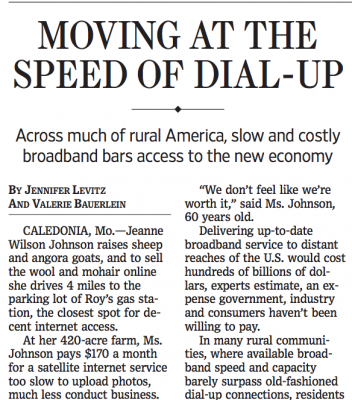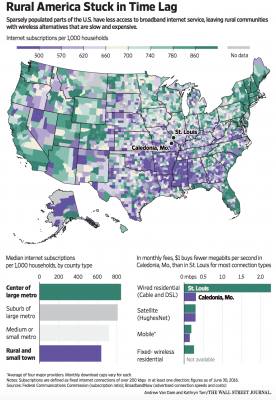Beef prices are projected to continue increasing as U.S. beef production declines with no signs of a cattle herd rebuild. Additionally, cheap beef may soon become further out of reach…
Rural America “Stranded in the Dial-Up Age,” Rural Broadband Issues
Last month, a Wall Street Journal article provided an in-depth look at a variety of statistical indicators from rural America in an article titled, “Rural America is the New, ‘Inner City.'” That article explained that, “In terms of poverty, college attainment, teenage births, divorce, death rates from heart disease and cancer, reliance on federal disability insurance and male labor-force participation, rural counties now rank the worst among the four major U.S. population groupings (the others are big cities, suburbs and medium or small metro areas).”
The Journal continued its “One Nation, Divisible” series with a front page article in Friday’s paper that focused on a different aspect of rural development: Broadband Internet access.

In “Moving at the Speed of Dial-Up,” Jennifer Levitz and Valerie Bauerlein reported that, “Jeanne Wilson Johnson raises sheep and angora goats, and to sell the wool and mohair online she drives 4 miles to the parking lot of Roy’s gas station, the closest spot for decent internet access.
“At her 420-acre farm, Ms. Johnson pays $170 a month for a satellite internet service too slow to upload photos, much less conduct business.
As in many rural communities, broadband here lags behind in both speed and available connections. Federal data shows only a fraction of Washington County’s 25,000 residents, including Ms. Johnson, have internet service fast enough to stream videos or access the cloud, activities that residents 80 miles away in St. Louis take for granted.
Friday’s article noted that, “In many rural communities, where available broadband speed and capacity barely surpass old-fashioned dial-up connections, residents sacrifice not only their online pastimes but also chances at a better living. In a generation, the travails of small-town America have overtaken the ills of the city, and this technology disconnect is both a cause and a symptom.
“Counties without modern internet connections can’t attract new firms, and their isolation discourages the enterprises they have: ranchers who want to buy and sell cattle in online auctions or farmers who could use the internet to monitor crops. Reliance on broadband includes any business that uses high-speed data transmission, spanning banks to insurance firms to factories.”
Levitz and Bauerlein pointed out that, “Rural counties with more households connected to broadband had higher incomes and lower unemployment than those with fewer, according to a 2015 study by university researchers in Oklahoma, Mississippi and Texas who compared rural counties before and after getting high-speed internet service.”

Last week’s article also indicated that, “About 39% of the U.S. rural population, or 23 million people, lack access to broadband internet service—defined as ‘fast’ by the Federal Communications Commission—compared with 4% of the urban residents.”
Fiber-optic trunk lines already make up much of the U.S. internet backbone. The trouble is reaching individual rural customers. It costs roughly $30,000 a mile to install optical fiber cable, according to industry estimates, to trench and secure right-of-way access.
The Journal article stated that, “Alternative internet technologies—satellite dish or fixed wireless, which uses cellular networks to beam data short distances using antennas and transmitters—struggle to handle video streaming or other high-data uses. Those services also typically cap the amount of data used each month.”
The article added that, “‘Rural broadband, we need that quite honestly more than we need roads and bridges in many of the counties I represent,’ U.S. Rep. Austin Scott (R., Ga.) said at a May 17 House committee hearing on the rural economy.
“Secretary of Agriculture Sonny Perdue said broadband connectivity should be seen as the ‘roads, sewers and water’ of the modern age. ‘The good news is, this is square on the radar scope of the president.’ he said at the hearing.”
Meanwhile, Aaron Gould Sheinin reported on the front page of Monday’s Atlanta Journal-Constitution that, “When bells ring at the end of the day in schools across rural Georgia, the local fast-food joints know what to expect.
“Gobs of students descend on the McDonald’s, Burger Kings and Wendy’s in small towns across the state.
“But it’s not a Big Mac, Whopper or Frosty many of the kids are after. It’s Wi-Fi.”
Front page in today's @ajc - "Rural Ga. a desert for broadband," https://t.co/ryjLAAQJSC #RuralAmerica #RuralDevelopment pic.twitter.com/nkVDnVHr4R
— Farm Policy (@FarmPolicy) June 12, 2017
The AJC article pointed out that, “Sixteen percent of Georgians do not have high-speed internet access, and the vast majority of those broadband deserts are in rural counties. While all public schools in Georgia have broadband internet, many students don’t. And in an age when web access is required for homework and other assignments, students go where they can to get online.”
“It’s not just students. Small businesses, the backbone of most rural communities, increasingly rely on the internet for ordering, sales, payroll and more,” the article said.
And Mr. Sheinin added that, “It is not a problem unique to Georgia. A recent Pew Research Center study found 73 percent of Americans have broadband access at home. For rural Americans, however, that number drops to 63 percent. ‘Broadband’ can mean many things, although the Federal Communications Commission defines it as internet access with speeds of 25 megabits per second.
The numbers are moving in the right direction, though. Ten years ago, only 35 percent of rural Americans had high-speed internet at home compared with just more than half of all Americans.
“In Georgia, too, access is improving. Georgia ranks 19th overall in broadband access and 14th for rural access, according to a state House of Representatives study.”





